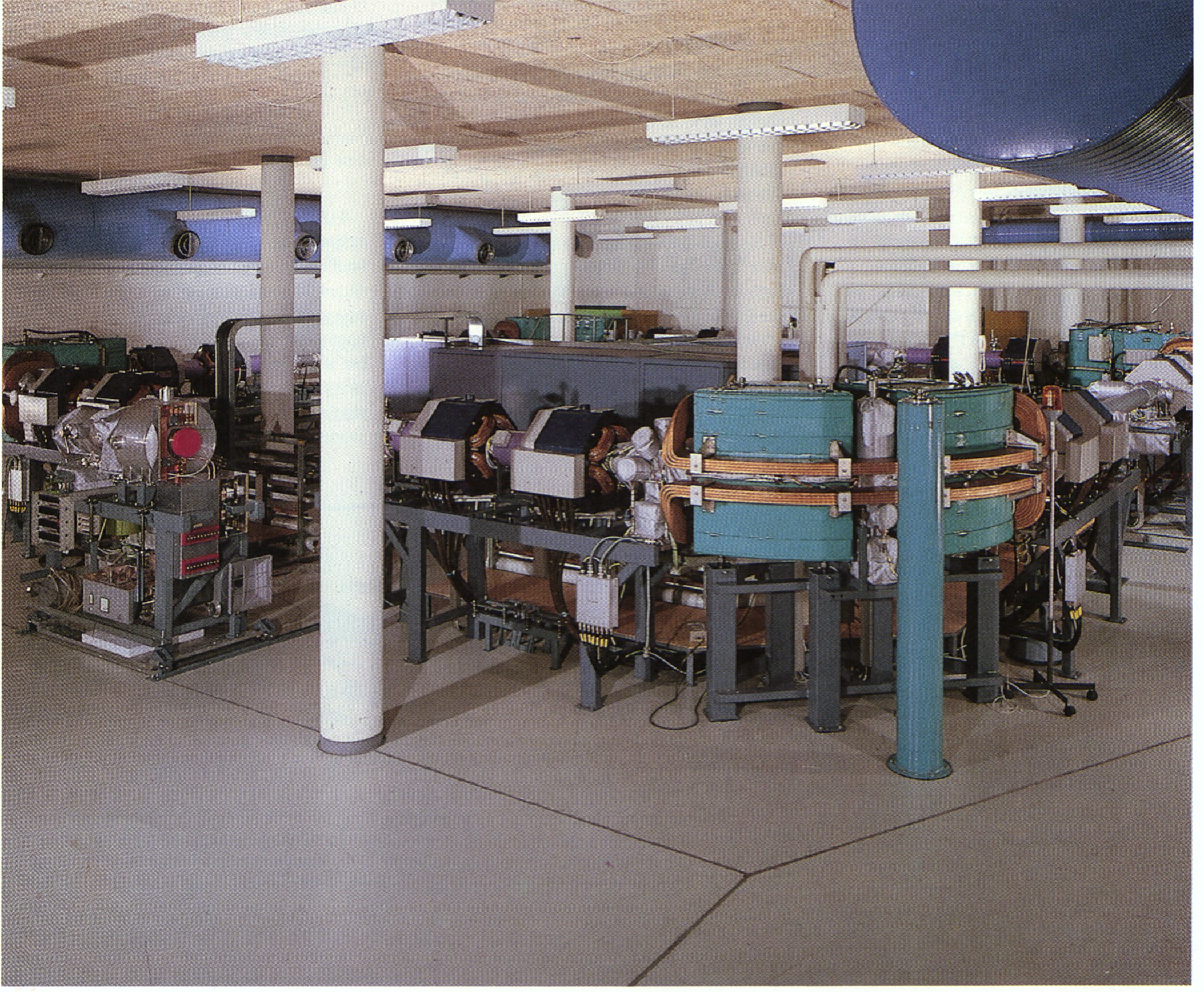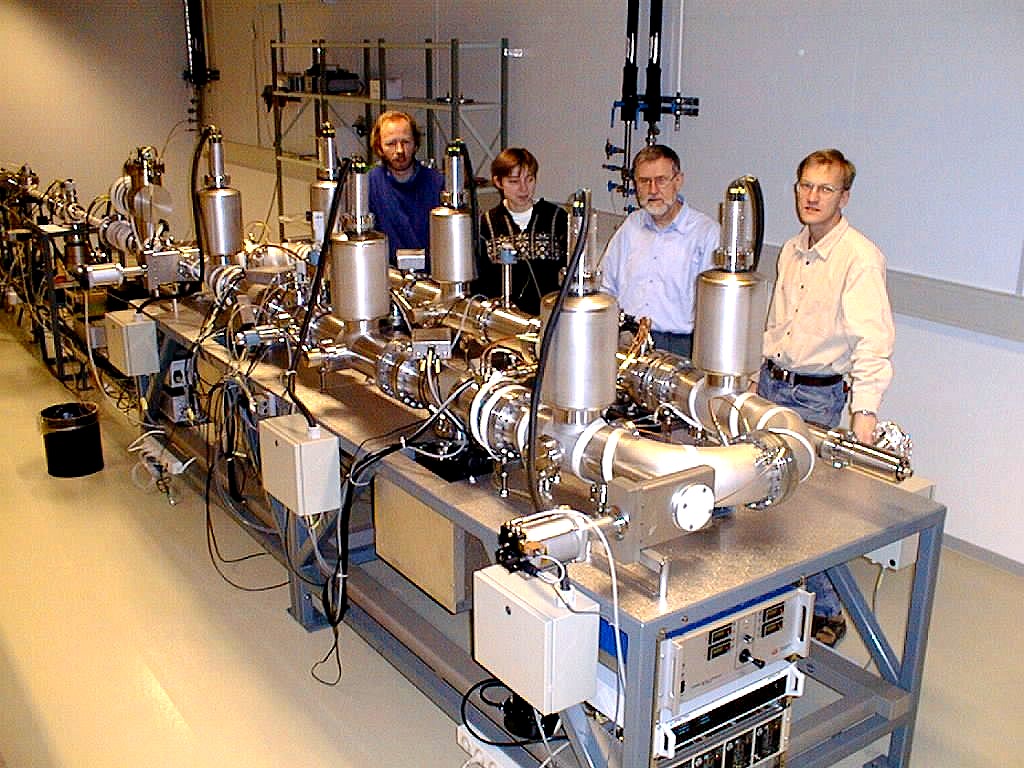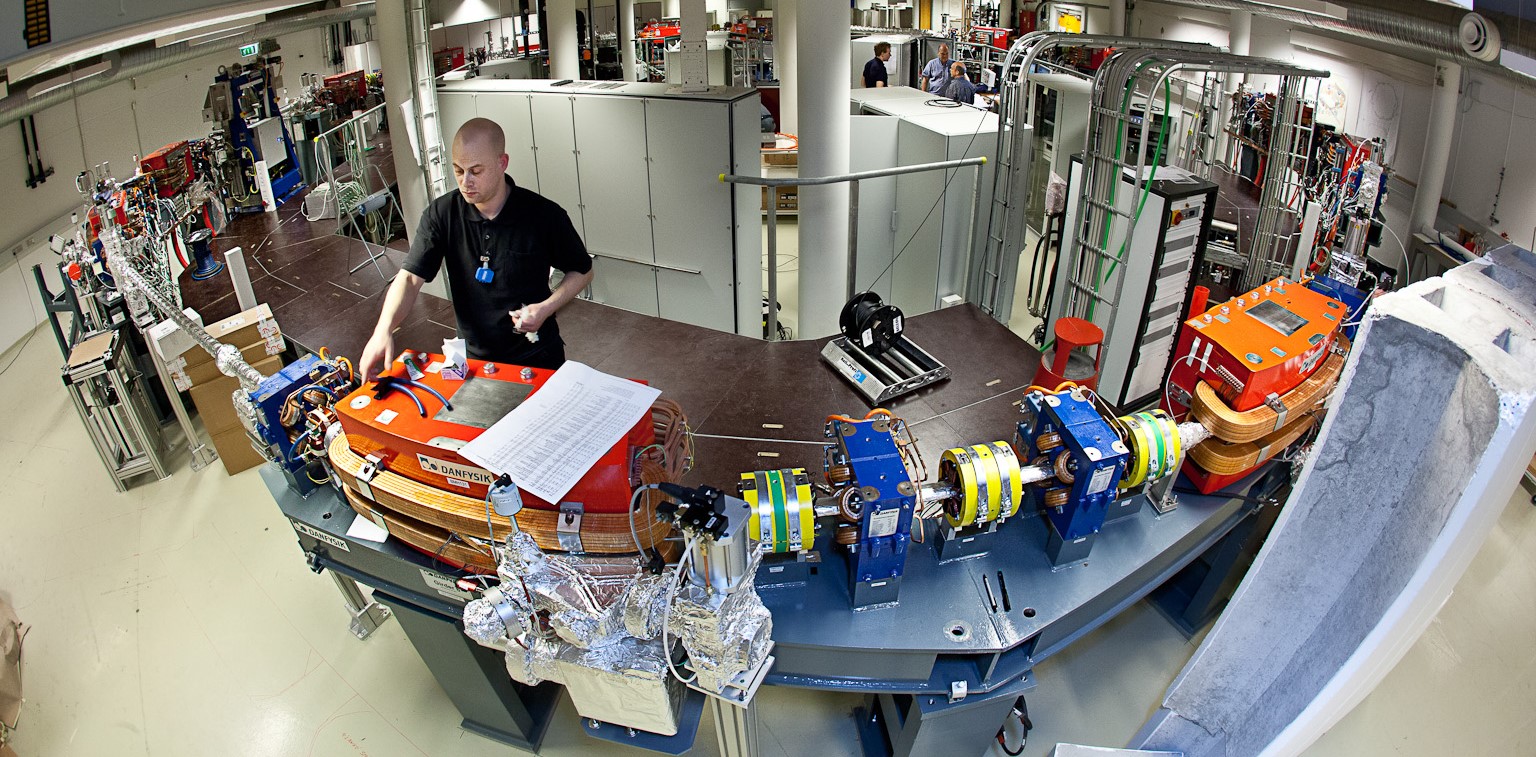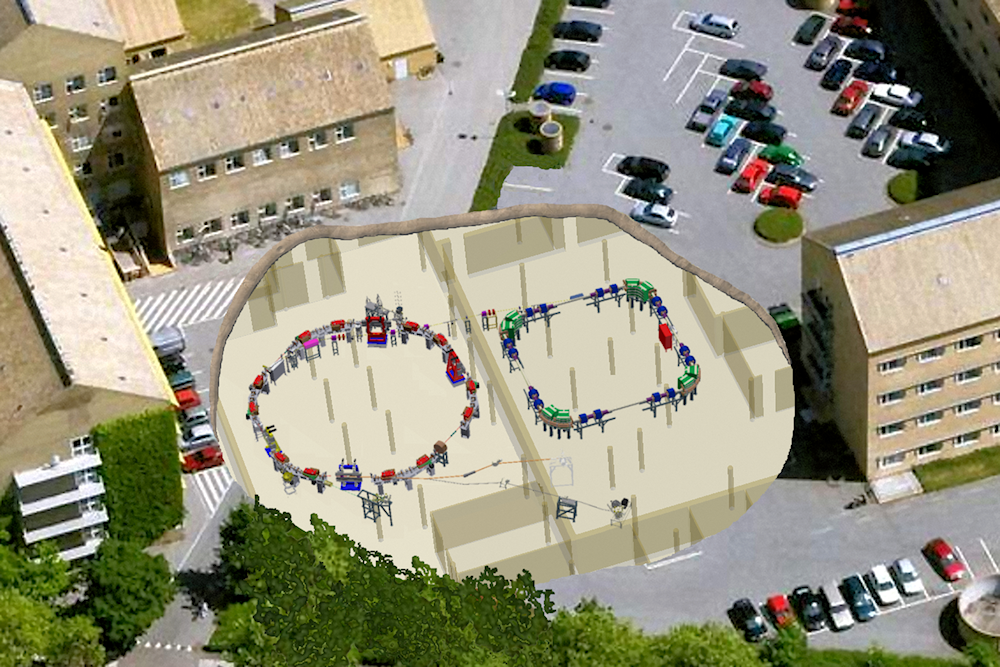Accelerators at IFA
Circular Accelerator developments at IFA in the last 35+ years,
|
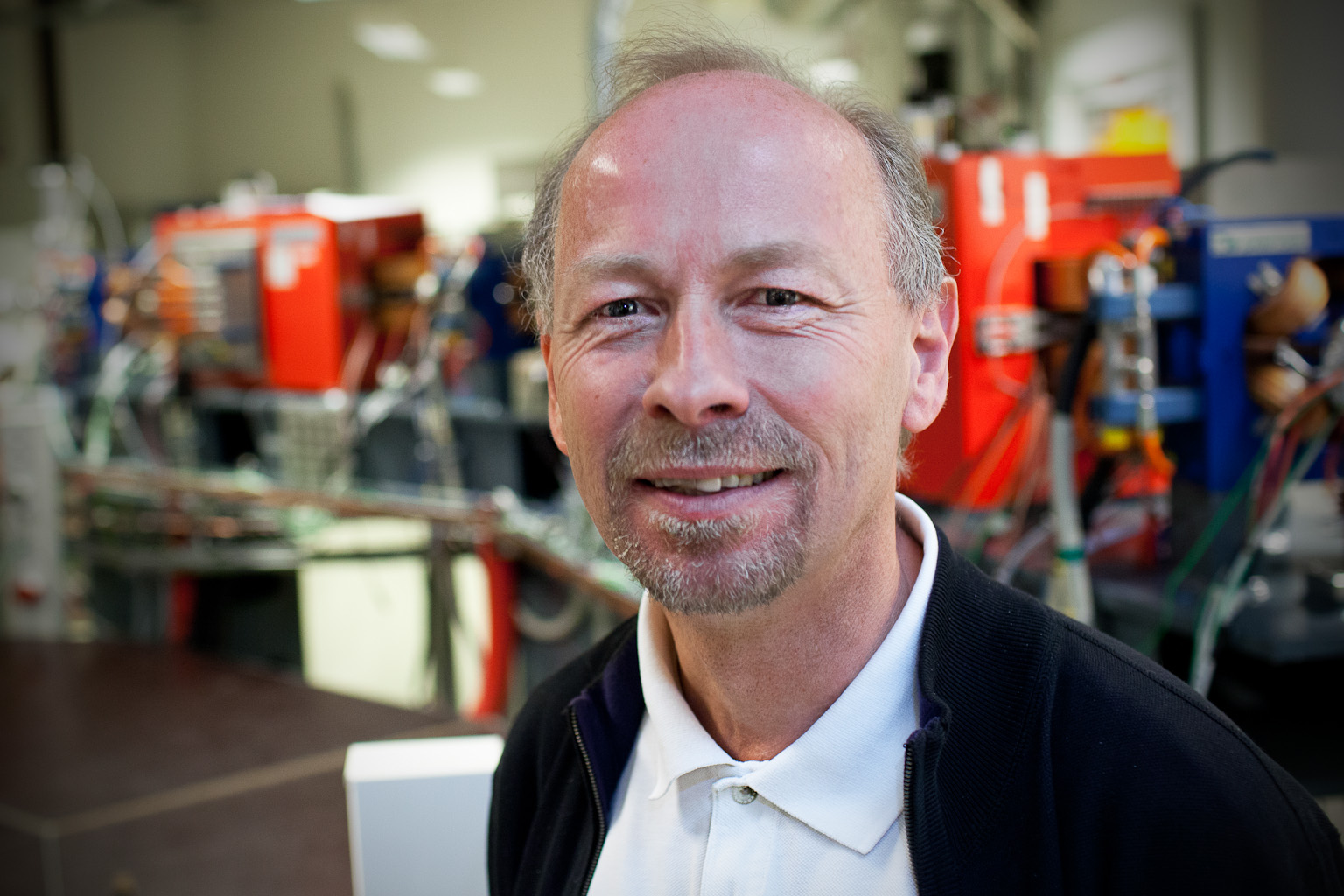 |
Prehistory and CERN
The development and expansion of the Department of Physics and Astronomy (Institut for Fysik og Astronomi, IFA) started in the 1960’s with the hiring of Professor Jens Lindhard. His research direction set the stage, synchronous with the entrepreneur and experimental physicists Professor Karl Ove Nielsen, and later Erik Uggerhøj together with many others.
A brief description of, in particular, the experimental physics research facilities with some references can be found here in the IFA webpages. Much of the research at that time was based on the use and development of accelerators. This article describes the later accelerator developments at IFA following the many single-stage accelerators built in the 1960’s and early 70’s and the move to the new building complex in 1974, including the large underground tandem accelerator.
New developments came in particular with Erik Uggerhøj and co-workers, conducting many experiments at CERN starting in the late 1970’s which continue to the present day. These CERN experiments followed on from the investigation of the interaction of charged particle matter using the accelerators at IFA, built from the mid 1960’s and onwards. At CERN, much higher particle energies were available, with more exotic particle types. One such exotic particle was the antiproton, where low-intensity beams had been available at CERN since the 1950’s, but which later became available in large quantities, as needed for the proton-antiproton collider at CERN; experiments led to the discoveries of the W and Z vector bosons in the early 80’s. Additionally, a low-energy antiproton facility was built, centered first around the antiproton decelerator (!), the Low Energy Antiproton Ring (LEAR), which was built to make antiproton beams available down to energies of 5 MeV. Later, energies all the way down to 100 keV and below became available with the Radio Frequency Quadrupole decelerator (RFQD) and more recently the Extra Low ENergy Antiproton ring (ELENA). In fact, the entire RFQD setup was transported to Aarhus in 2000 to be tested and optimized with protons before final installation at CERN. The study of physics with antiprotons is important, in particular for precision experiments with anti-hydrogen, led by Jeffrey Hangst, but it was also used as a continuation of atomic and collision physics at IFA with heavy particles of negative charge.
Supervised by Erik Uggerhøj, I became involved in research at CERN in the late 1970's. My own experimental work at CERN started as a summer student and later with other work in Erik Uggerhøj’s group working at CERN. I wrote my Master thesis based on work at CERN, and later also my PhD (Licentiat) and Dr. Scient. In 1979-1980, almost a complete year of beamtime in the South Hall at the Proton Synchrotron with beams of ~1-15 GeV +/- protons, pions and electrons was used. Other partners were the groups of George Charpak (later to become a Nobel laureate) and Fabio Sauli at CERN with multi-wire chambers, and crystals and solid-state detectors from IFA or the group at CNRS in Strasbourg led by Paul Siffert. This gave great opportunities to us as young students, almost working on our own, with sufficient funding and ample resources for equipment and time and access to CERN, IFA and more. Many students were involved, many supervised by Erik Uggerhøj: few details, wild ideas and a wide range of trust and many results emerged!
Following experiments in the South Hall, there were further channeling experiments in the East Hall and later at higher energies at the Super Proton Synchrotron up to 250 GeV, also using electrons and positrons for studies of the newly discovered channeling radiation. From 1981-1983, I had the opportunity to have a fellowship at CERN for 2½ years. In 1983, we got in contact with the soon to come low-energy antiprotons, and I took part in the commissioning of the Low Energy Antiproton Ring in the South Hall. Later on, there was further work at CERN with antiprotons from LEAR, initially at 5 MeV and then further degradation to 100 keV, conducting experiments with slowly extracted antiproton beams. These antiprotons were at energies overlapping those available at IFA, and many atomic and solid-state physics experiments were conducted. I took part in the commissioning of LEAR, together with mentors such as Pierre Lefévre, Dieter Möhl, Flemming Pedersen, Michel Chanel and others. This was inspiring, involved a lot of accelerator physics and laid the seeds for the new facilities at IFA; it was around this time that the first ideas about new circular accelerators and storage rings in Aarhus originated.
ASTRID
The first ideas came up soon after my return from CERN, with Erik Uggerhøj as ”chief driver”. First designs were a “mini-LEAR” named “Aarhus STorage RIng, Denmark” (ASTRID) for positive and negative ions with electron and laser cooling, injectors from existing accelerators including the Tandem accelerator, Ultra High Vacuum <1 x 10-11 mbar, injection and extraction systems, Radio Frequency acceleration, beam diagnostics and all other necessary components. As an intermezzo, although a beamline from the Tandem accelerator to the new ring was planned, and some concrete work was made and is still visible, no beams ever made it to ASTRID from the Tandem.
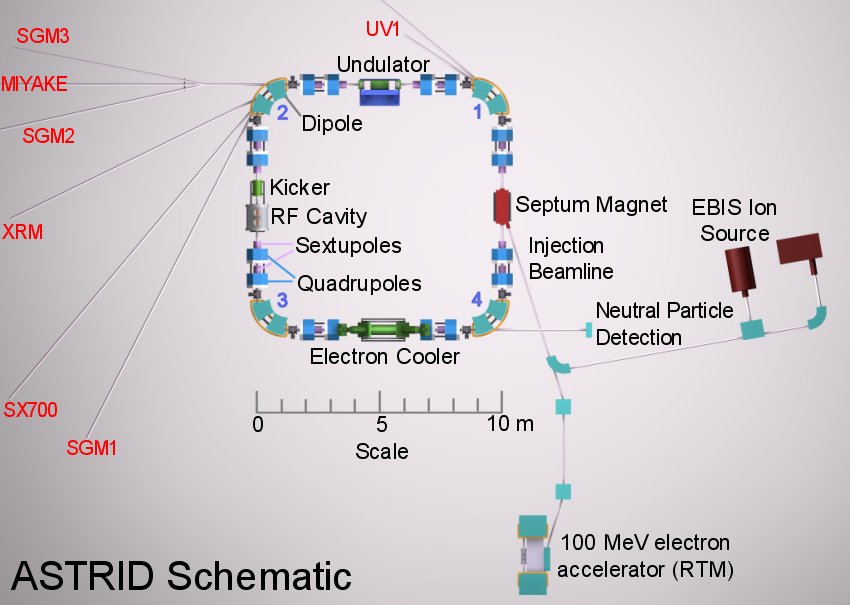
Figure: Schematic overview of the ASTRID ring, showing the beam lines (labelled in red) that used synchrotron light and the injection systems for ions (right) and electrons (bottom).
The design of ASTRID required the estimation of lifetimes of the storage of particles, and they turned out to be from fractions of seconds to many tens of seconds for the estimated pressures. After the first “paper designs”, the question came up from Erik Uggerhøj, who had also been interested in synchrotron radiation x-rays at DESY, if the ASTRID accelerator could also store electrons for synchrotron radiation. My answer was yes, but that the ring should be designed for stable and optimal synchrotron radiation cooling of the electron beam in all three planes. The first designs of a 33.6 m diameter ASTRID ring were modified and the ASTRID lattice design with a circumference of 40 m was eventually frozen and constructed (Schematic Fig. 1). Hence, ASTRID became a dual-purpose storage ring, the first of its kind, with either storage of ions for studies in atomic physics or of 580 MeV electrons to produce intense beams of synchrotron radiation for atomic, surface, bio and medical physics in the wavelength range from the IR to the soft x-rays up to 1 keV. Parts of the accelerator hardware had to be exchanged to go from one mode of operation to the other, e.g. the two very different radio-frequency systems and the removal/insertion of the undulator. This dual-purpose operation of a synchrotron storage ring was conceptually new, and was chosen to have a broad local user community at the relatively small department, but also aimed to attract external users from the rest of Denmark and abroad.
Following ASTRID, at around the same time and also later on, other smaller rings were built, like the TSR in Germany, CRYRING in Sweden and TARN in Japan and others, also used for studies in atomic and molecular physics. To build such a relatively large research infrastructure such as ASTRID was a big challenge to IFA, as it involved a large number of technicians and physicists at IFA over several decades. It also involved very many technologies previously unknown to the department, including UHV (<1 x 10-11 mbar), measurements of very low pressures, very clean components, very stable high-current power supplies, very sensitive beam diagnostics and currents, radio-frequency systems, magnet designs and construction, computer control systems and much more. A sound base for many of the technologies turned out to exist at IFA, but clearly help from many foreign laboratories were needed including CERN, DESY, BESSY and many more. These many constructions had the big benefit of keeping the technical staff at IFA up to date with recent technology, which is actually still the case! |
|
In 1986, a frozen design of ASTRID was presented; a design which turned out to be very successful and is operable even now. Financing was obviously also a challenge, but in the end (1990) sufficient funds amounting to 13.5 MDKK were collected from various private and public funds, including the faculty of science at Aarhus University with the Dean Karl Pedersen. In addition, a new underground laboratory had to be built under the parking lot between the Departments of Physics and Chemistry. This underground laboratory was later extended to more than double the size to make room for the new synchrotron radiation light source ASTRID2 and other underground laboratories, see below.
First atomic physics experiments in ASTRID were performed starting in 1991, with numerous atomic and molecular ions of positive and negative charge such as H-, D+, He-, Li+, OH-, CN-, Al12-,C60++, C60-, 56Fe- and many more. Also many different atomic physics experiments were carried out including lifetime measurements of metastable beams, laser-cooling, electron cooling, electron recombination and much more. Additionally, experiments with extracted beams of high-energy electrons were made for tests of high-energy detectors for CERN. Some industry related experiments were also done over the years, including irradiation of diamonds by high-energy (100 MeV) electrons.
From 1994, synchrotron radiation from the so-called second-generation ASTRID source with, at that time, a competitive horizontal emittance of 140 nm available for several experiments for a handful of beamlines and end-stations. Injection and accumulation of 100 MeV electrons from the, also!, newly designed – mainly by Niels Hertel - and constructed electron racetrack microtron, yielded circulating currents in ASTRID of 100-200 mA accelerated to 580 MeV with only small losses. As there was no radiation shielding between the beamlines and the ASTRID accelerator, the ring hall had to be evacuated during injections. After filling, the ring hall was opened for users; the beam lifetime was initially several hours, which over time increased to more than 100 hours and only one injection was needed every morning. The people who used ASTRID were not only local AU users, but also from Aalborg, Odense, Copenhagen, and abroad, stretching from Europe to the US and Australia. ISA also became a member of the European Synchrotron Radiation Community, taking part in many three or four year transnational access EU-funded projects. Among other things, these programmes enabled funding for access to ASTRID for approved users, including travel costs and payment of user fees to ISA. This European community of light sources has evolved over the years and are today an official association known as LEAPS, the League of European Accelerator based Photon Sources, of which ISA is a member.
ELISA
During discussions about experiments studying so-called Ramsey-fringes in ASTRID, the disturbance of the magnetic quadrupoles resulting in magnetic gradient fields was realized. This is when the first idea came about to use electrostatic lenses and later also deflectors, proposed by Torkild Andersen and myself. First designs were actually using two 180 degrees bending magnets. A fully electrostatic ring seemed immediately to be a good idea, but as this good idea had never been tried before, people were skeptical about its feasibility. No support could be found in the literature, but eventually a simulation (SIMION) with realistic electrostatic fields strongly supported the feasibility of the idea. A design of the electrostatic ring ELectrostatic Ion Storage ring, Aarhus (ELISA) for 20 keV ions, with the simplest geometry of an elongated racetrack, was finished and the ring was built and commissioned with only minor and solvable problems (1997). The system was built bakeable to high temperature, 300 C, and had an average pressure below 10-11 mbar. Cooling to around -100 C with liquid nitrogen could also be done. Lifetimes of 10’s of seconds were obtained for the storage of ions, and although the influence of space-charge effects was seen for intense beams above several nA, this was never a problem for the most interesting ion species. Many pioneering experiments were made, ELISA being the first ring of its kind. Over the years many electrostatic rings have been built, some close to the design of ELISA, but other designs have also been made, with operation to cryogenic temperatures of few K possible. In the end, based on the ELISA design, I was awarded the 1998 European Accelerator Prize. To date, close to 10 electrostatic storage rings have been built, some utilizing double rings and other rings of very different geometry. At IFA, other electrostatic ion storage rings have also been built and operate at IFA, e.g. SAPHIRA.

Figure: Schematic overview of ELISA.
Very many different ions of both polarities, both atomic and molecular, and light and heavy ions like N+ , Ar+ , Xe+ , D2+ , N2+, CO+ , O- , O3- , C36-96- , Alx- , Cux, Agx-, C2H2- C6H14N4O2H+ and many more have been investigated in the electrostatic rings. One significant advantage for electrostatic rings is that ions with the same kinetic energy can be stored with the same setting, as opposed to magnetic rings.
Involvement in external accelerator projects
Via the accelerator expertise obtained, in particular at ASTRID, myself and co-workers became strongly involved as consultants and with the education of industrial PhD’s, for other accelerator projects, in particular with the Danish company DANFYSIK. This involved the design and commissioning of booster electron synchrotrons as injectors for the synchrotron light sources like ANKA in Karlsruhe, Germany, the Canadian Light Source in Saskatoon, Canada and the Australian Synchrotron in Melbourne, Australia. Furthermore, I was employed by DANFYSIK, and later Siemens, to consult on the design of carbon ion therapy facilities in Shanghai, China and in Marburg, Germany. Related to this, is the advisory role in connection to the specification and selection of the vendor for what became the Danish Center for Particle Therapy. It should also be mentioned that IFA was involved in the European Spallation Source (Lund, Sweden) from the start of the project with various designs, and in the end supplied the so-called Raster Scanning System delivering the up to 5 MW beam, controllably dispersed on the target, together with some additional components. We also developed, built and tested together with DANFYSIK and others, permanent-magnet bending dipoles, removing the need for a power-hungry power supply. The prototype magnet built as part of this collaboration is successfully still operating today, almost ten years after installation in the transfer beamline between ASTRID and ASTRID2. This knowledge could become useful in connection to a conversion of ASTRID2 to permanent magnets.
ASTRID2
After operating the ASTRID accelerator system for a number of years as a light source, soon after the turn of the millennium, ideas for a brighter light source to replace ASTRID started. Initially, a higher energy ring was discussed, but ASTRID2 ended up with the same energy as ASTRID to focus on the UV, VUV and soft x-ray regime, but with much brighter beams from a 10 nm emittance electron beam. A new underground laboratory next to that of ASTRID was completed in 1998. In December 2008, ISA/IFA was awarded 37 MDKK from governmental research infrastructure funds for ASTRID2. This new ring would also include new insertion devices and new beamlines and a transfer beamline from ASTRID, which then would be converted into a booster synchrotron, and much more.
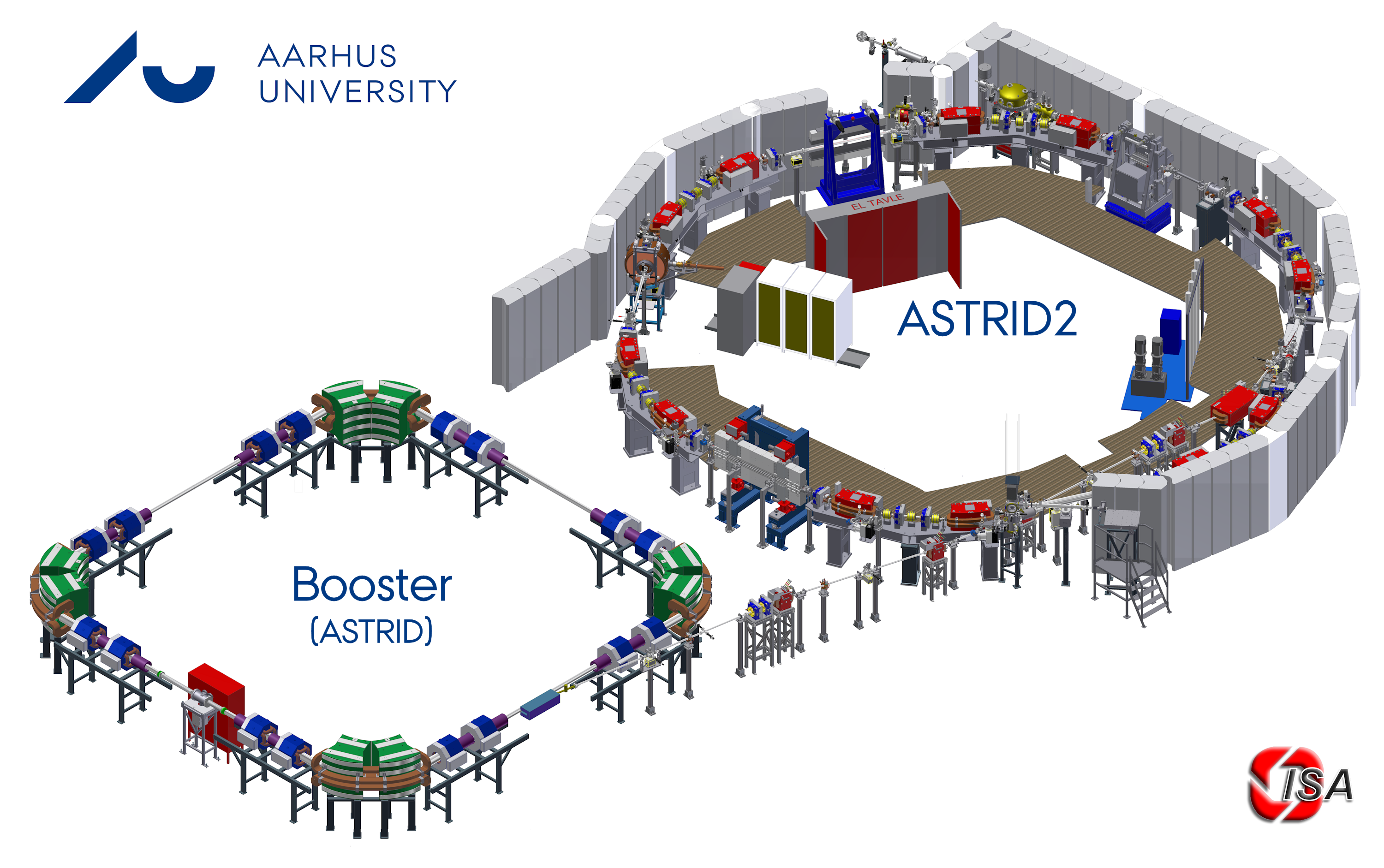
Figure: 3D CAD model of the newer ring ASTRID2 and the ASTRID, used as the booster ring for full energy top-up injections into ASTRID2.
Following the announcement of the grant in 2008, the design was frozen in late 2009, with first light in 2012 and all beamlines operational in 2014, within budget! This modern “ultimate” third-generation light source, ASTRID2, results in an almost diffraction-limited storage ring of 10 nm emittance at 580 MeV, with ASTRID used for top-up injection, delivering a virtually constant level of high current beams. The instantaneous lifetime is around 5 hours. Synchrotron radiation used in experiments on the beam lines is from dipoles, two undulators and one multi-pole 2T wiggler.
|
Due to its low energy and small beam-losses, ASTRID2 is, as far as we know, the only synchrotron in the world, that can be seen during operation. Part of the synchrotron light is projected onto the ceiling and is visible during operation to the many visitors to the facility e.g. school classes. The most recent development was in 2022, when a new beamline with an end-station for a micro-focus Angle-Resolved Photo-Electron Spectroscopy system (nano-ARPES) was commissioned and put into use.
ASTRID2 operates around the clock 24/7 with an automated control system, for around 35 weeks per year, with high availability 95%+, and a mean time between failures of 3-4 weeks. Due to the relatively small core staff of 6 people, repairs are mainly only during working hours with the assistance of the department's technicians. Typically, over 100 users use the facility annually, with around a third coming from Aarhus University and other universities in Denmark, and the rest from abroad, travelling from as far as Brazil, US, Australia and India. Typically, around 40 proposals requesting beam time are received annually, resulting in around 40 reviewed papers per year.
Last Modified 09 May 2025
